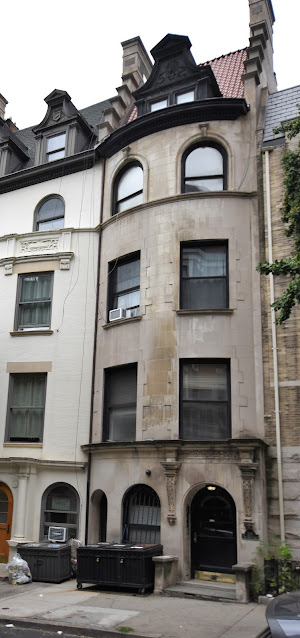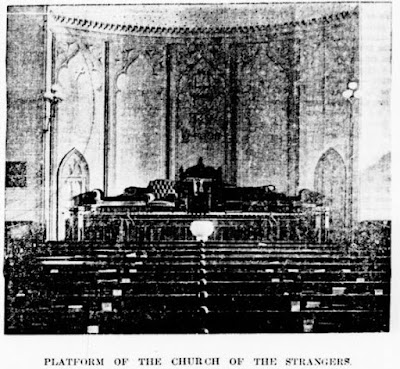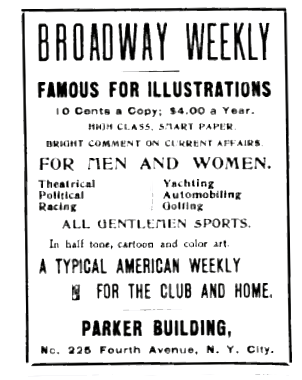Bricklayer Benjamin Wise and mason Joseph Whitehead erected a row of five houses on the north side of East 17th Street, between Second and Third Avenues, in 1855. A year earlier they had acquired the lots from Lewis Rutherford--Whitehead buying three lots, and Wise the two eastern plots. Although their speculative homes would be essentially identical, a gap in the otherwise continuous cornice between 114 and 116 East 17th Street delineated the separate projects.
Wise sold 116 East 17th Street (renumbered 217 in 1866) to Juste Lanchantin. The Anglo-Italianate style house was faced in red brick above the rusticated brownstone basement and parlor levels. A short stoop led to the arched, double-doored entrance.
Born in Paris in 1796, Lanchantin was an importer at 162 Broadway. He had married Emma Milnor Caille in New York City in 1831, and the couple had two young adult children, Paul Henry and Clara.
Paul was working as a clerk by 1859. He doubled as a volunteer firefighter at the Metamore Hose Company No. 29 on Fifth Avenue and 21st Street. He had married Ellen Hern and the couple remained in the East 17th Street house with his parents.
In September 1859 Paul and Ellen had a baby, Charles Emile. Sadly, the little boy died on January 4 1860, four months after his first birthday. There was no notice of a funeral, The New York Times simply saying the following day that "The remains will be taken to Greenwood Cemetery for interment this day...at 1 o'clock P.M., from the residence of his grandfather."
The family was understandably much involved in the French-speaking community. On April 17, 1865 Juste was appointed a warden of the French Protestant Episcopal Church du Saint Esprit.
The Lanchantin family left East 17th Street in 1867. Their former residence became home to the Julius Frankel family. An esteemed physician, Frankel was born in Berlin in 1808 where he studied medicine beginning in 1830. By the time he arrived in New York City in 1844, he had studied medical hygiene throughout Europe as well as in today's Israel and Palestine. He became connected with the Eastern Dispensary, which served the impoverished families of the Lower East Side. In 1856 he established a class there for treating diseases of children, and in 1862 helped create the city's first Sanitary Commission.
Frankel and his wife, the former Matilda Bresina, had two children, Edward and Clara. Although still a teenager, Edward was studying at the College of Physicians and Surgeons when the family moved into 217 East 17th Street. He graduated in 1868, The New York Times noting that he was "so young, 19, that he needed special permission to graduate." The article added, "he won the first Faculty prize with his thesis on the 'Congenital Malformations of the Heart.'"
It was, no doubt, the Frankel family that gently updated the appearance of the house by adding cast metal cornices over the brownstone lintels. Nothing else of the design was changed.
As was common even among the well-to-do, the family took in a boarder. Charles Goodrich, a widowed real estate developer, took the room for a short time in 1872. Early that year he placed an advertisement in a newspaper, which was answered by a 25-year-old woman, Lizzie Lloyd King (who identified herself as Kate Stoddard). A relationship developed, and around the time he left the Frankel house, Goodrich married her--except it was a sham marriage, a friend of Goodrich posing as a minister.
Goodrich quickly tired of his "wife," and did everything he could think of to rid himself of her. Soon after the wedding he wrote her, saying "it is better for both that we should separate," and his last letter to her offered to provide her a room in New York City and financial aid if she would cease calling herself Mrs. Goodrich and not mention their relationship to his family.
But Lizzie King was not to be spurned. She stalked her abuser, and when he tried to oust her from his Brooklyn home on March 20, 1873, she shot him three times in the head with his own pistol. It was a sensational murder trial, one that would involve one of the Frankel's servants.
Adelaide Cahn was called to testify. On July 13, 1873 the New York Herald reported, "On taking the stand she was much overcome by her feelings." She identified Goodrich's watch, which was found in Lizzie's possession, and his pocketbook. The article said, "The two revolvers in possession of the Coroners were produced, when she said she had seen one of them in the possession of Goodrich." She was then asked if she recognized Lizzie King. The New York Herald reported, "She took a long, steady look at 'Kate,' and said she had seen her before at 217 East Seventeenth street, where deceased had had a room; the prisoner was in his company at the time; this was in June or July of last year."
It came out at trial that Goodrich was, indeed, a scoundrel and Lizzie King was not his only victim. The New York Herald reported, "Miss Cahn was, it was said, at one time the affianced of Charles Goodrich."
Elizabeth King was convicted of the murder and committed to the State Lunatic Asylum in Auburn, New York.
The Frankel's boarder in 1879 was William Baumgarten, a cabinetmaker who had immigrated from Germany in 1865. He was affiliated with the esteemed Herter Brothers shop--decorators of the mansions of millionaires like William Henry Vanderbilt, Potter Palmer, and Mark Hopkins. He would remain with the family for years.
On January 29, 1881 Julius Frankel died at the age of 72. In reporting his death, the New York Herald wrote, "Dr. Frankel was an intimate friend of the late Mayor [William Henry] Havemeyer, Elijah Purdy and many other prominent New Yorkers. He wielded a large influence in politics in a quiet way. Dr. Frankel died peacefully, surrounded by his family, and none but those immediately connected with him were aware of the passing away of a remarkable man who had spent a laborious life, but who remained modestly in retirement."
The close relationship between the Frankels and their boarder was evidenced in an article in The Evening Post on July 15, 1882. It listed among the passengers on the Britannic, headed for Liverpool, England, Dr. Edward Frankel and William Baumgarten. And, as a matter of fact, on May 7, 1887 Baumgarten was married to Clara Frankel. By now he had been the head of Herter Brothers for six years.
In 1900 Baumgarten hired architect William Schickel, whom he knew well through their work together with Herter Brothers, to design an opulent townhouse at 294 Riverside Drive for him, Clara, and their growing family.
Dr. Edward Frankel remained in the family home. He was the attending surgeon at the City Hospital on Blackwell's Island, and a consulting surgeon to the New York Hospital. In addition to his medical practice, he was active in civic activities. In 1895, for instance, he had been appointed a School Inspector by Mayor William Lafayette Strong. After having lived at 217 East 17th Street for more than half a century, Frankel died in his bedroom here on December 16, 1923 at the age of 75.
The narrow house was not converted to a multi-family dwelling until 1980, when a renovation resulted in a duplex on the first and second floors, one apartment on the third, and two on the fourth. A subsequent remodeling produced a triplex in the cellar through second floors, one apartment on the third, and a "fine arts studio" on the top floor.
photograph by the author
no permission to reuse the content of this blog has been granted to LaptrinhX.com
























